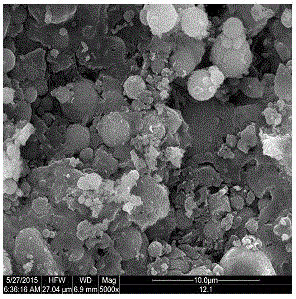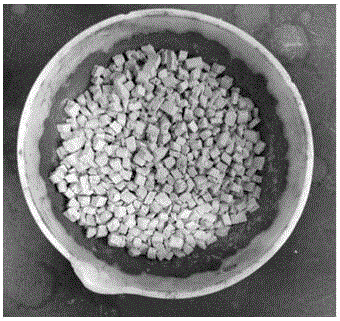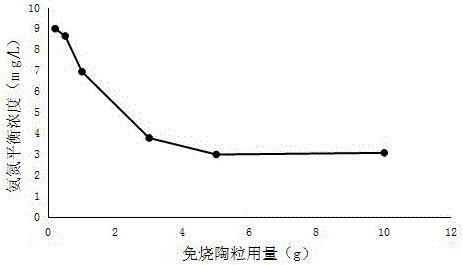Preparation method of non-sintered ceramsite with ammonia nitrogen adsorption function
A technology of ammonia nitrogen and ceramsite, which is applied in the field of preparation of unfired ceramsite, can solve problems such as secondary pollution, and achieve the effects of increasing strength, increasing activity, and low cost
- Summary
- Abstract
- Description
- Claims
- Application Information
AI Technical Summary
Problems solved by technology
Method used
Image
Examples
Embodiment 1
[0058] 1) Pretreatment of raw materials: Soak fly ash at 25°C for 3 days with 5% NaOH solution by mass percentage, wash it with deionized water, and dry it in an electric constant temperature drying oven at 105°C. The surface of the coal ash is modified to enhance its adsorption capacity for ammonia nitrogen; the remaining sludge, calcium oxide, sodium bicarbonate, and Portland cement taken from the dehydration workshop of the urban sewage plant are dried at 105°C; all the above raw materials After drying, pulverize through a pulverizer and pass through a 100-mesh sieve for subsequent use;
[0059] 2) Mixing of raw materials: fully mix the above pretreated raw materials according to the following mass ratio: 70.9% of fly ash, 7.1% of calcium oxide, 7% of residual sludge, 1% of sodium bicarbonate, and 9% of Portland cement;
[0060] 3) Granulation: dissolving water glass with a mass percentage of 5% in 34g / (100g dry weight) water, then pouring into the mixed raw materials and s...
Embodiment 2
[0071] 1) Pretreatment of raw materials: Soak fly ash at 25°C for 3 days with 5% NaOH solution by mass percentage, wash it with deionized water, and dry it in an electric constant temperature drying oven at 105°C. The surface of the coal ash is modified to enhance its adsorption capacity for ammonia nitrogen; the remaining sludge, calcium oxide, sodium bicarbonate, and Portland cement taken from the dehydration workshop of the urban sewage plant are dried at 105°C; all the above raw materials After drying, pulverize through a pulverizer and pass through a 100-mesh sieve for subsequent use;
[0072]2) Mixing of raw materials: fully mix the above pretreated raw materials according to the following mass ratio: fly ash 68%, calcium oxide 7%, excess sludge 10%, sodium bicarbonate 1%, Portland cement 9%;
[0073] 3) Granulation: dissolving water glass with a mass percentage of 5% in 34g / (100g dry weight) water, then pouring into the mixed raw materials and stirring evenly to make a ...
Embodiment 3
[0078] 1) Pretreatment of raw materials: Soak fly ash at 25°C for 3 days with 5% NaOH solution by mass percentage, wash it with deionized water, and dry it in an electric constant temperature drying oven at 105°C. The surface of the coal ash is modified to enhance its adsorption capacity for ammonia nitrogen; the remaining sludge, calcium oxide, sodium bicarbonate, and Portland cement taken from the dehydration workshop of the urban sewage plant are dried at 105°C; all the above raw materials After drying, pulverize through a pulverizer and pass through a 100-mesh sieve for subsequent use;
[0079] 2) Mixing of raw materials: The above pretreated raw materials are fully mixed according to the following mass ratio: 72% of fly ash, 4% of calcium oxide, 10% of excess sludge, 3% of sodium bicarbonate, and 6% of Portland cement;
[0080] 3) Granulation: dissolving water glass with a mass percentage of 5% in 34g / (100g dry weight) water, then pouring into the mixed raw materials and ...
PUM
| Property | Measurement | Unit |
|---|---|---|
| specific surface area | aaaaa | aaaaa |
| density | aaaaa | aaaaa |
| specific surface area | aaaaa | aaaaa |
Abstract
Description
Claims
Application Information
 Login to View More
Login to View More - R&D
- Intellectual Property
- Life Sciences
- Materials
- Tech Scout
- Unparalleled Data Quality
- Higher Quality Content
- 60% Fewer Hallucinations
Browse by: Latest US Patents, China's latest patents, Technical Efficacy Thesaurus, Application Domain, Technology Topic, Popular Technical Reports.
© 2025 PatSnap. All rights reserved.Legal|Privacy policy|Modern Slavery Act Transparency Statement|Sitemap|About US| Contact US: help@patsnap.com



